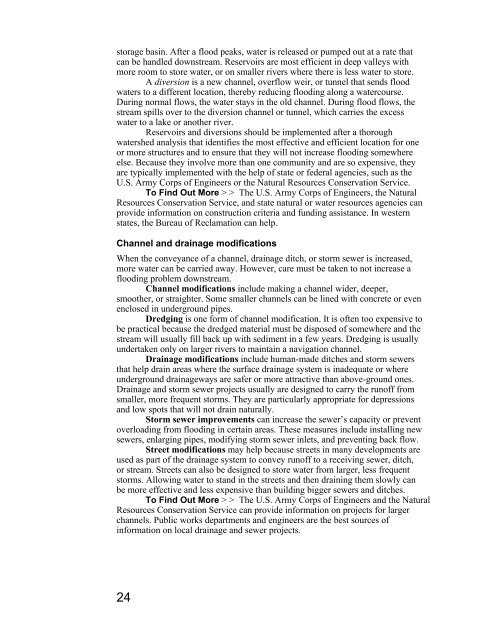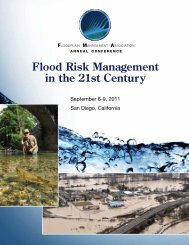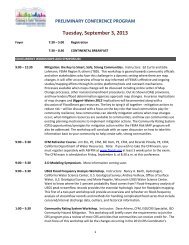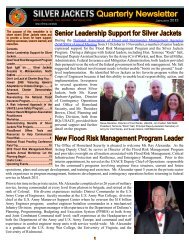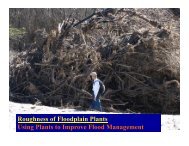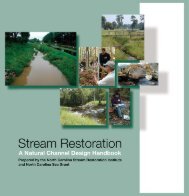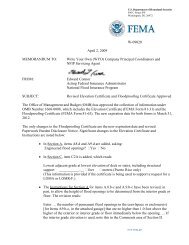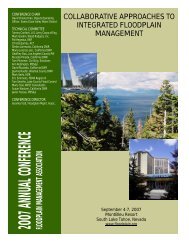Using Multi-Objective Management to Reduce Flood Losses in Your
Using Multi-Objective Management to Reduce Flood Losses in Your
Using Multi-Objective Management to Reduce Flood Losses in Your
You also want an ePaper? Increase the reach of your titles
YUMPU automatically turns print PDFs into web optimized ePapers that Google loves.
s<strong>to</strong>rage bas<strong>in</strong>. After a flood peaks, water is released or pumped out at a rate that<br />
can be handled downstream. Reservoirs are most efficient <strong>in</strong> deep valleys with<br />
more room <strong>to</strong> s<strong>to</strong>re water, or on smaller rivers where there is less water <strong>to</strong> s<strong>to</strong>re.<br />
A diversion is a new channel, overflow weir, or tunnel that sends flood<br />
waters <strong>to</strong> a different location, thereby reduc<strong>in</strong>g flood<strong>in</strong>g along a watercourse.<br />
Dur<strong>in</strong>g normal flows, the water stays <strong>in</strong> the old channel. Dur<strong>in</strong>g flood flows, the<br />
stream spills over <strong>to</strong> the diversion channel or tunnel, which carries the excess<br />
water <strong>to</strong> a lake or another river.<br />
Reservoirs and diversions should be implemented after a thorough<br />
watershed analysis that identifies the most effective and efficient location for one<br />
or more structures and <strong>to</strong> ensure that they will not <strong>in</strong>crease flood<strong>in</strong>g somewhere<br />
else. Because they <strong>in</strong>volve more than one community and are so expensive, they<br />
are typically implemented with the help of state or federal agencies, such as the<br />
U.S. Army Corps of Eng<strong>in</strong>eers or the Natural Resources Conservation Service.<br />
To F<strong>in</strong>d Out More > > The U.S. Army Corps of Eng<strong>in</strong>eers, the Natural<br />
Resources Conservation Service, and state natural or water resources agencies can<br />
provide <strong>in</strong>formation on construction criteria and fund<strong>in</strong>g assistance. In western<br />
states, the Bureau of Reclamation can help.<br />
Channel and dra<strong>in</strong>age modifications<br />
When the conveyance of a channel, dra<strong>in</strong>age ditch, or s<strong>to</strong>rm sewer is <strong>in</strong>creased,<br />
more water can be carried away. However, care must be taken <strong>to</strong> not <strong>in</strong>crease a<br />
flood<strong>in</strong>g problem downstream.<br />
Channel modifications <strong>in</strong>clude mak<strong>in</strong>g a channel wider, deeper,<br />
smoother, or straighter. Some smaller channels can be l<strong>in</strong>ed with concrete or even<br />
enclosed <strong>in</strong> underground pipes.<br />
Dredg<strong>in</strong>g is one form of channel modification. It is often <strong>to</strong>o expensive <strong>to</strong><br />
be practical because the dredged material must be disposed of somewhere and the<br />
stream will usually fill back up with sediment <strong>in</strong> a few years. Dredg<strong>in</strong>g is usually<br />
undertaken only on larger rivers <strong>to</strong> ma<strong>in</strong>ta<strong>in</strong> a navigation channel.<br />
Dra<strong>in</strong>age modifications <strong>in</strong>clude human-made ditches and s<strong>to</strong>rm sewers<br />
that help dra<strong>in</strong> areas where the surface dra<strong>in</strong>age system is <strong>in</strong>adequate or where<br />
underground dra<strong>in</strong>ageways are safer or more attractive than above-ground ones.<br />
Dra<strong>in</strong>age and s<strong>to</strong>rm sewer projects usually are designed <strong>to</strong> carry the runoff from<br />
smaller, more frequent s<strong>to</strong>rms. They are particularly appropriate for depressions<br />
and low spots that will not dra<strong>in</strong> naturally.<br />
S<strong>to</strong>rm sewer improvements can <strong>in</strong>crease the sewer’s capacity or prevent<br />
overload<strong>in</strong>g from flood<strong>in</strong>g <strong>in</strong> certa<strong>in</strong> areas. These measures <strong>in</strong>clude <strong>in</strong>stall<strong>in</strong>g new<br />
sewers, enlarg<strong>in</strong>g pipes, modify<strong>in</strong>g s<strong>to</strong>rm sewer <strong>in</strong>lets, and prevent<strong>in</strong>g back flow.<br />
Street modifications may help because streets <strong>in</strong> many developments are<br />
used as part of the dra<strong>in</strong>age system <strong>to</strong> convey runoff <strong>to</strong> a receiv<strong>in</strong>g sewer, ditch,<br />
or stream. Streets can also be designed <strong>to</strong> s<strong>to</strong>re water from larger, less frequent<br />
s<strong>to</strong>rms. Allow<strong>in</strong>g water <strong>to</strong> stand <strong>in</strong> the streets and then dra<strong>in</strong><strong>in</strong>g them slowly can<br />
be more effective and less expensive than build<strong>in</strong>g bigger sewers and ditches.<br />
To F<strong>in</strong>d Out More > > The U.S. Army Corps of Eng<strong>in</strong>eers and the Natural<br />
Resources Conservation Service can provide <strong>in</strong>formation on projects for larger<br />
channels. Public works departments and eng<strong>in</strong>eers are the best sources of<br />
<strong>in</strong>formation on local dra<strong>in</strong>age and sewer projects.<br />
24


